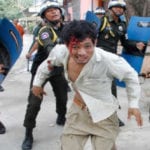 Weird Stuff
Weird Stuff  Weird Stuff
Weird Stuff  Movies and TV
Movies and TV Top 10 Ghost Adventures Episodes That Will Haunt You Forever
 Animals
Animals Ten Animals That Produce and Store Toxins in Unlikely Places
 Weird Stuff
Weird Stuff 10 Weird Things That Warp Your Sense of Time
 Miscellaneous
Miscellaneous Ten More Extremely Unexpected U.S. State “Firsts”
 Humans
Humans 10 Ideas That Scare People to Death
 Music
Music The Cursed Decade: 10 Classic Rock Stars Who Had Low Periods in the 1980s
 Health
Health 10 Crazy Ways Sleep Deprivation Can Affect You
 History
History 10 Enthralling Facts about the Field of Cloth of Gold
 Pop Culture
Pop Culture The Ten Greatest Engineers in Science Fiction History
 Weird Stuff
Weird Stuff 10 Surprising Things That Were Designed to Stop Evil Behavior
 Movies and TV
Movies and TV Top 10 Ghost Adventures Episodes That Will Haunt You Forever
 Animals
Animals Ten Animals That Produce and Store Toxins in Unlikely Places
Who's Behind Listverse?

Jamie Frater
Head Editor
Jamie founded Listverse due to an insatiable desire to share fascinating, obscure, and bizarre facts. He has been a guest speaker on numerous national radio and television stations and is a five time published author.
More About Us Weird Stuff
Weird Stuff 10 Weird Things That Warp Your Sense of Time
 Miscellaneous
Miscellaneous Ten More Extremely Unexpected U.S. State “Firsts”
 Humans
Humans 10 Ideas That Scare People to Death
 Music
Music The Cursed Decade: 10 Classic Rock Stars Who Had Low Periods in the 1980s
 Health
Health 10 Crazy Ways Sleep Deprivation Can Affect You
 History
History 10 Enthralling Facts about the Field of Cloth of Gold
 Pop Culture
Pop Culture The Ten Greatest Engineers in Science Fiction History
10 Signs We Are Headed Into World War III
When confusion and misinformation get together in the dark, paranoia is born. Fears of war, violence, and oppression fester and grow in the minds of the populace pushing everything but a misguided assurance of certain doom into the shadows. Out of this cramped and huddled mindset we get the bastardized half-brother of critical thinking: conspiracy theories.
SEE ALSO: Top 10 Catalysts for World War III
Claiming that World War III is just over the horizon is as crazy as it gets, but the state of the world is showing some eerie similarities to the pre–World War II global picture. And history is a creature of habit.
10 An Unexpected Invasion

On February 27, 2014, Russian soldiers strapped on their marching boots and took over several airports in Crimea. As this is being written, roughly 6,000 Russian troops are moving across the Crimean peninsula and forcibly taking operational control of military bases, communications centers, and government buildings.
This is an invasion that has been a long time in the making, and it’s certainly not the first time Russia has made power plays in the Ukraine. Ever since 1783, Ukraine and Russia (for a time the Soviet Union) have played hot potato with Crimea, leaving a bubbling brew of split nationalism struggling to coexist on the little peninsula.
But the arrival of Russian troops is just the most recent step in a tumultuous few weeks for Ukraine. The country has seen its Russia-sympathizing president, Viktor Yanukovych, become a fugitive, a Russian citizen become the Crimean city of Sevastopol’s mayor, and an emergency meeting of Crimea’s parliament elect Sergey Aksyonov as the new Prime Minister of Crimea—at gunpoint. Aksyonov has declared that he will follow orders from the ousted Yanukovych, who is currently seeking refuge in Russia. The country’s politics are in tatters.
Get the full story with Putin’s Wars: The Rise of Russia’s New Imperialism at Amazon.com!
9 The Ukrainian Conflict Is Reaching A Boiling Point

Ukrainian nationalists are calling Putin’s invasion an act of war; Russians in Ukraine are calling it an act of salvation. Riots are flaring up all across the country as the two dominant political forces come to a head. This video shows two men being beaten by a pro-Russian mob in Kharkiv, the USSR’s Bolshevik-run capital leading up to World War II—and that’s where Putin’s army looks headed next.
You can get a pretty clear view of the political alliances of Ukraine with the above map, which shows the results of the 2010 election. Blue represents areas that supported Viktor Yanukovych, so you can consider those regions comparatively pro-Russian. The purple areas voted for an opposing candidate, Yulia Tymoshenko. The darker the color, the stronger the support. Kharkiv and Donetsk are firmly in the blue, and represent two major Ukrainian cities with a strong industrial infrastructure—and both are historically Russian.
This is a group of very assertive, very nationalistic people at arms over the one issue that holds paramount importance: heritage. And historically, gray areas are reserved for the losers; it’s the inflexible, dyed-in-the-wool believers in a cause who triumph in a conflict. Russia sees this as good news, picturing much support from the country they’re invading. As one Ukrainian bitterly put it, “No one asked us. We are like puppets for them. We have one Tsar and one god—Putin.”
8 Russia’s License For Aggression

Though the UN, NATO, and the US have all gone on high alert, the Crimean invasion isn’t an act of aggression against the whole world. It’s a move to make parts of Ukraine decisively Russian, both culturally and politically. Obama initially warned that there would be “costs” to this invasion, but he won’t back it up—he can’t, not without a game of nuclear Russian roulette, which nobody wants.
The problem isn’t that America and the UN will start tossing bombs into Russia; the problem is that Putin knows they won’t. This is a man who once said that the fall of the Soviet Union was the “greatest geopolitical catastrophe of the 20th century,” a viewpoint which harkens to the days of Stalin’s Great Purge and Khrushchev’s missile diplomacy with Cuba.
And Putin’s already on round two. In 2008, when Putin was still Prime Minister, Russia and Georgia entered a five-day conflict that culminated in Russian bombs falling on the Georgian capital. Humanitarian groups around the world cried out, governments issued strict warnings for Russia to fall back, and nobody lifted an actual finger to stop it. At the end of it all, Russia calmly strolled back home and declared that Georgia had been “sufficiently punished.” Each time this happens, Russia becomes more assured that the warnings of the rest of the world are just that—words, empty and hollow.
The situation in Ukraine may not be a match that’s going to ignite the fires of World War III, but it’s a nod to a superpower that they have a free license to do what they want. And if you give a mouse a cookie . . .
7 The Senkaku Island Dispute

Russia’s not the only country setting the stage for World War III. As is the case with most important things, World War II didn’t suddenly flash into existence; it edged its way into the world consciousness one little bit at a time, like a slowly rusting bicycle, until war was officially declared. While it’s easy to put the conflict into the simplest terms, a lot of factors combined to make up what we now view as one war.
The years leading up to the war held a lot of indicators that, in hindsight, revealed aggressive countries testing the waters of what they could get away with. Japan, Italy, and Germany were all involved in minor conflicts that the League of Nations couldn’t stop, such as Italy’s invasion of Ethiopia in 1935 and Japan’s chemical-infused invasion of China in 1937.
These days, China is reversing the balance by threatening an invasion of its own. The territory in question is a group of rocks known as the Senkaku islands, which are located in the East China Sea. The problem, of course, is that both China and Japan feel that the islands belong to them, and whoever controls the islands also controls shipping lanes, fishing waters, and a potential oil field.
6 A Third Sino-Japanese War In The Making

China hasn’t been the nicest neighbor recently. In November 2013, China startled the world by announcing a newly configured air defense zone in the East China Sea—a zone that they and they alone would control, to the point of shooting down aircraft that wandered into it. But, in addition to Japan, other regions originally had claim to that airspace, including Taiwan and South Korea.
Whether or not China was planning an invasion at that point, the Senkaku islands fall inside their “newly acquired” airspace, and now they’re threatening to forcefully move Japan out of the area. Tensions have been building in the Pacific Rim for a while now, and if military action puts too much pressure on the skeleton of their current political disputes, bones could break.
And unlike the first two Sino-Japanese wars, this conflict could involve other countries in the region. South Korea quietly expanded their own airspace in December 2013, pushing back into territory that China had already claimed. Combined with both China and Japan aggressively rearming themselves in recent years, this territorial dispute has the potential to explode.
5 America Is Legally Bound To Protect South Pacific Countries

A war only becomes a World War when the US gets involved. Unlike their official policy of stern warnings and disapproving looks in response to Russia, the White House has publicly and unwaveringly declared that it will back Japan against any acts of aggression by China.
With about 50 percent of its Naval force stationed in the Pacific, the US will also be in a position to help the Philippines if China continues pressing to the south. They’re yet another country that has been affected by the airspace changes, and the US is legally bound to protect the Philippines based on the 1951 Mutual Defense Treaty.
This treaty doesn’t even require anything as outright as a full-scale land invasion. The Philippines owns disputed islands within China’s new airspace in the South China Sea (much like Japan claims to own the Senkaku islands). If China makes a move on any of those, the US Navy has to retaliate on their behalf, or they’ll break the conditions of the treaty.
4 Unlikely Alliances

But beneath it all, what do China’s problems and Russia’s problems have to do with each other?
Although they initially ended up on opposite sides of the conflict, Germany and the USSR went into World War II with a non-aggression pact, which lasted two years until Hitler ripped it up and sent Nazis onto Soviet ice.
With perhaps some similarities to that historic pact, China and Ukraine signed a nuclear security pact in December 2013. The conditions: China won’t use any nuclear weapons against Ukraine, and if Ukraine is ever attacked by a nuclear force—or “threatened by such aggression“—China will provide Ukraine with security guarantees.
Why would China want to create such a pact with a country 5,800 kilometers (3,600 mi) away? And more importantly, with which government is China going to honor the pact? The past two months have seen a see-saw of political parties in control of Ukraine, but it’s likely that China’s involvement will be dependent on Yanukovych’s politics, which are decidedly pro-Russian. He’s the one who signed the pact. China says its relationship with Russia is warmer than ever, with China’s People Daily describing it as “one of the most active power relationships [in the world].”
It’s been speculated that Russia is hoping to draw a Western attack onto Ukraine, so that China’s entry to back Ukraine will cement the alliance between China and Russia. That idea reeks of conspiracy theory. But with Russia’s recent agreement to supply $270 billion in oil supplies to China, and with the majority of Russia’s pipelines running through Ukraine, China would want to protect its own interests. Either way, the enemy of an enemy is always a friend, and US-Russian relations are on very shaky ground.
Could it actually happen? Find out in World War 3: 2014 at Amazon.com!
3 Iran Is Itching For War

While tension rises on the Eastern European front and Southeast Asia is mired in an explosive territorial dispute, rumors of war are also being whispered in the Middle East—specifically, Iran. But is Iran any real threat? Depending on the spin, it’s easy to think so.
In January 2014, Iran dispatched a fleet of ships toward US national waters. The Senate has decided that unless military action is taken, Iran’s nuclear development will continue unchecked. And on February 12, 2014, Iran’s military chief answered that claim by declaring the country’s willingness to go toe-to-toe with American forces, on land or at sea.
It sounds like a crisis in the making, but it’s not as bad as it seems. Those “warships” were a rusty frigate and a supply boat, the White House in no way backs the Senate’s bill, and while Iranian general Hassan Firouzabadi did threaten the US and the “Zionist regime” (Israel), it’s worth remembering that they’ve done so plenty of times in the past.
Another point of contention is Iran’s military force. Including paramilitaries, Iran states that they have 13.6 million people who can pick up a weapon at a moment’s notice. While that number is probably exaggerated, it doesn’t matter much anyway—World War III, if it happens, will be mostly an aerial war dependent more on long-range technologies than close-quarters combat. And that, surprisingly, is an example of why not to count Iran out of the picture. They have an air force of 30,000 men with several hundred aircraft, along with cruise missiles with a range of 2,000 kilometers (1,240 mi). That’s plenty of range to hit US bases in the Gulf.
But most importantly, continued attention on Iran, Syria, and other Middle Eastern countries is spreading the West’s foreign resources a little too thin, especially now that Russia won’t be any help in that region.
2 North Korea Is A Wild Card

North Korea tends to get relegated to the back row in discussions on world powers. They’re potentially dangerous, sure, but it’s a short-range type of danger, similar to the way you can still skip away from a mugger with a knife. But turn your back for too long, and that mugger can sneak up and give you some scars.
North Korea is still firing missiles in South Korea’s direction for no good reason. The most recent launch was March 2, 2014; they fired more the week before that. With a range of about 500 kilometers (300 mi), the missiles won’t reach far—just to, say, Japan. Or China. Or South Korea, or Russia. And since they’re nestled right in the center of three of the biggest threats to peace at this time, they could—purposely or not—stir up something bigger than themselves, like dropping a starved weasel into a den of sleeping bears.
Most frightening of all, North Korea is building a nuclear arsenal. It’s unlikely that they’ll ever lead with a nuclear attack, but if there’s enough chaos going on around them, it’s not impossible that they’ll try to slip one into the mix.
1 A Global Recession

World War I and World War II were very different from each other, but they had one striking similarity. Prior to each war, economic recessions hit several of the countries involved. World War II famously brought most of the world’s economies back from the Great Depression, and World War I helped the US recover from a two-year recession that had already slowed trade by 20 percent. Correlation doesn’t imply causation, but it’s worth noting which economies recovered earlier than others, which may have had a huge impact on the way things turned out.
By 1933, Japan had taken moves to devalue its currency, which led to increased exports and a resulting growth in their economy. They pumped the extra money into weapons and munitions, which gave them a decided military advantage in the years leading up to the war. Germany, on the other hand, entirely crashed, which made the Nazi and Communist parties take similar steps and earn overwhelming support among the populace.
We’re seeing some similarities today. While analysts are predicting yet another economic meltdown for Western countries, countries like Iran and Russia are looking to band together to boost their economies. Among other effects, that could lead to a second unit on Iran’s nuclear plant; Germany’s massive internal spending in the 1930s pulled it out of the Depression faster than America or the rest of Europe. And the global recession hit Russia less than much of the rest of the world, due in part to its exports of a quarter of the natural gas used by the entire European continent
And then there’s China. The US government is close to $17 trillion in debt, and China owns seven percent of that, or about $1.19 trillion. China recently flew past Japan to become the world’s second largest economy, and if it keeps growing at this rate, its GDP is going to match America’s in about eight years. The risk is if China decides to dump the US debt. China would take a financial loss, but it could be a crippling blow to the US economy—and much of the world, since the US dollar is held in reserve by most foreign governments.
If China and the US do come to blows over the South China Sea, the US could eradicate the debt and pump the extra revenue into military spending—the exact same monetary flow that happened in World War II, only this time the guns are bigger.
But don’t worry, it won’t happen. Probably.








